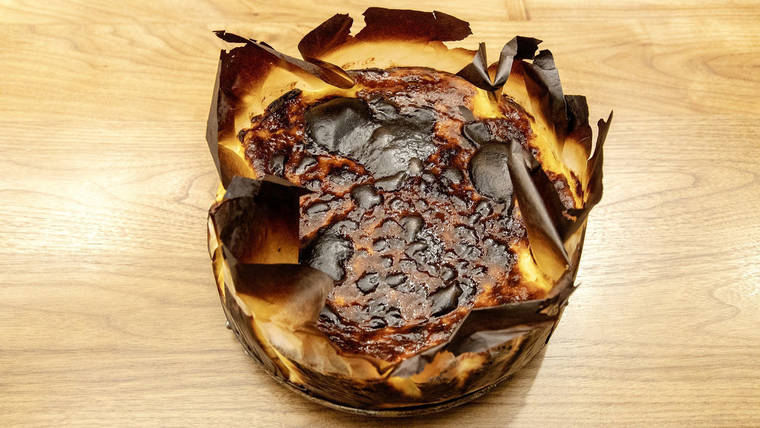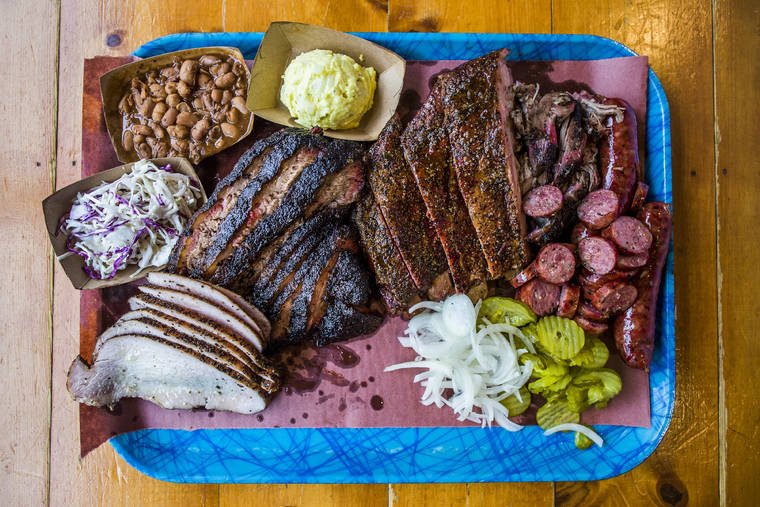Predictions to chew on for 2021

NEW YORK TIMES
Basque cheesecake has slipped into more mainstream food culture.

NEW YORK TIMES
Pinto beans, potato salad, pork ribs, pulled pork, sausage, pickles, onions, brisket, turkey and coleslaw fill a meal kit fom Franklin Barbecue in Austin, Texas. Such kits are expected to grow in popularity.


Predicting food trends is a dubious exercise in any year, but those who dabble in the dark art of culinary prognostication have never faced a landscape harder to read than 2021.
Most forecasters agree there will be no frivolous food or “breakout” cuisines delivered amid the pandemic and the stumbling economy.
But innovation and a restaurant rebound will come, eventually. The most optimistic believe that the cork will pop out of the bottle by summer. “If we can ride the wave of what’s going to be a crappy winter, it’s going to be like the Roaring ’20s all over again,” said Andrew Freeman of the hospitality marketing and public relations companies AF&Co. and Carbonate.
Others see a much slower transition, in which home cooking remains popular and cautious diners venture out into a radically different restaurant landscape than the one they left. Independent restaurants will likely remain in free fall, while chains like McDonald’s continue to profit.
Economically, there will be two worlds, each eating very differently than the other. Diners who made it through the pandemic with jobs and health intact are aching to spend money at restaurants. On the flip side are legions of Americans, including 2.3 million bar and restaurant workers, who remain unemployed or in a deep financial hole.
>> RELATED: Hawaii restaurants rose above 2020’s challenges Opens in a new tab
Don't miss out on what's happening!
Stay in touch with breaking news, as it happens, conveniently in your email inbox. It's FREE!
>> RELATED: Words that shaped the way we ate in 2020 Opens in a new tab
It may be ugly, but it will also be interesting. These predictions come from market researchers, academics and other forecasters.
Meal kits from chefs
A year ago, meal kits had been left in the dust as consumers tired of strict subscription models, packaging waste and the amount of actual kitchen labor they required. Then the pandemic sent everyone back to the kitchen, and meal kits once again seemed like a good idea — so good that chefs got into the game.
Diners, hungry for a taste of their favorite restaurants and willing to do what they could to keep them in business, made them a hit. These new kits range from a $475 roast-duck package (from Eleven Madison Park in New York) and a $159 mail-order goat shoulder for six (from Stephanie Izard of Girl & the Goat in Chicago) to less expensive options like the $21 double-stack burger for two (from H&F Burger in Atlanta) and a plethora of taco kits in Los Angeles.
Drinks from cans
Over the past several years, craft brewers have increasingly been putting their beers into aluminum cans, which are better for the environment than bottles and better for the beer. That shift went into overdrive this year, when breweries were no longer able to sell kegs in volume to bars and restaurants.
Coupled with a nascent craze for wines and cocktails in cans, that led to a temporary can shortage. Cans now hold all kinds of beverages, including new drinks like hard kombucha and breakfast seltzers, which feature a mix of coffee and booze.
The boom could fast-track can recycling and improve manufacturing.
Vegetable of the year: Take your pick
Food forecasters always anoint a vegetable they expect to take off in the new year. It was chicory in 2017 and celtuce last year. In 2021, any vegetable will do.
Health and immunity will continue to be major concerns, and foods and flavors that have a wellness halo should sell briskly, especially vegetables. Some grocery stores report that sales remain up by more than 30% over last year.
Jenny Zegler, associate director of food and drink for the global market research firm Mintel, said people are likely to appreciate this control over their diets even after things normalize. “We’ve had an awakening about how our diets can impact our susceptibility to the disease.”
Flavor of the year: Basque cheesecake
This crustless “burnt” cheesecake, baked in a very hot oven so the top caramelizes but the inside remains jiggly, came out of San Sebastian, Spain, in the 1990s. Some elite American chefs started making versions, and two years ago it slipped into more mainstream food culture.
Chefs in New York and San Francisco have dedicated themselves to perfecting the cheesecake; it is now a soft-serve flavor in Singapore and may become the birthday-cake or cookie butter flavor of 2021.
Food for sleeping
The era of the energy drink is over. All the stress and anxiety of 2020 has created a new market for food and drinks that claim to promote relaxation and sleep.
Companies are searching for “what they can add to their arsenal in addition to the weighted blanket and meditation app and hot tea,” Zegler said.
Pepsico’s Driftwell is water enhanced with magnesium and L-theanine, an amino acid that some studies show can relax the mind without drowsiness.
Look for relaxing snacks, like Goodnight, a nighttime chocolate nibble with ingredients to help you sleep, and Nightfood, a bedtime ice cream with sleep-inducing minerals, digestive enzymes and less sugar.
Homegrown tastes
With international travel quashed and Americans taking fewer long trips across the country, the new domestic focus will feed an interest in hyper- regional American food.
That means renewed interest in state-specific barbecue styles, locally made sodas and cheeses, fish species from nearby waters and sweet specialties like the chocolate-dipped peanut butter Ohio buckeye or Kentucky cream pull candy. (Corollary trend: New Nostalgia, embracing modern takes on TV dinners, state-fair food-to-go, and restaurants like Big Kids in Chicago, which offers grown-up versions of fried bologna sandwiches and the Taco Bell Crunchwrap.)
Delivery, evolved
The pandemic exposed the predatory pricing of some food delivery services and the economic damage they’ve done to restaurants that suddenly had to rely on delivery for most of their income.
This year will bring a realignment as more restaurants develop their own online ordering systems. The pickup experience will change, too, as restaurants track diner preferences, polish the curbside experience and improve the quality of takeout food.
Not too far in the future, predictive technology braced with data from a wide array of restaurants will give birth to something as easy to use as Netflix, said Michael Wystrach of the meal service Freshly. “That will be one of the largest tectonic shifts we’ve seen since fast food,” he said, “and maybe since frozen food.”
Waste, trimmed
While months of home cooking and the recession have led to thriftier kitchens and a new appreciation for using vegetable trimmings and chicken carcasses, concern about packaging waste has largely been put on hold.
Many shoppers have stopped using their own bags at the grocery store and don’t think twice about heavily packaged, plastic-wrapped meal deliveries.
“It’s all about safety and convenience,” said Amanda Topper, associate director of food service for Mintel. She and others, however, expect concern about waste and interest in compostable or reusable containers to rise once the threat from COVID-19 wanes.
Habits that linger
The pandemic spurred fundamental changes in how we live and eat, and several will become even bigger: online grocery shopping, plant-based eating, ghost kitchens, direct ordering from farms and local dairies, and acts of culinary self-reliance like bread baking and gardening.
Home cooking isn’t going away, either. “Even once restaurants reopen, the amount of food that is cooked and prepared at home will be higher by 30%” than it would have otherwise, said Keith Knopf, president and chief executive officer of Raley’s, which owns 126 grocery stores in California.
Labels worth reading
Building on a growing interest in products with natural (and fewer) ingredients, consumers will start to look for labels that go far beyond the government- required information to detail the product’s environmental and social impact.
Companies owned by women and people of color are a selling point, as are products with small environmental footprints.
© 2021 The New York Times Company



